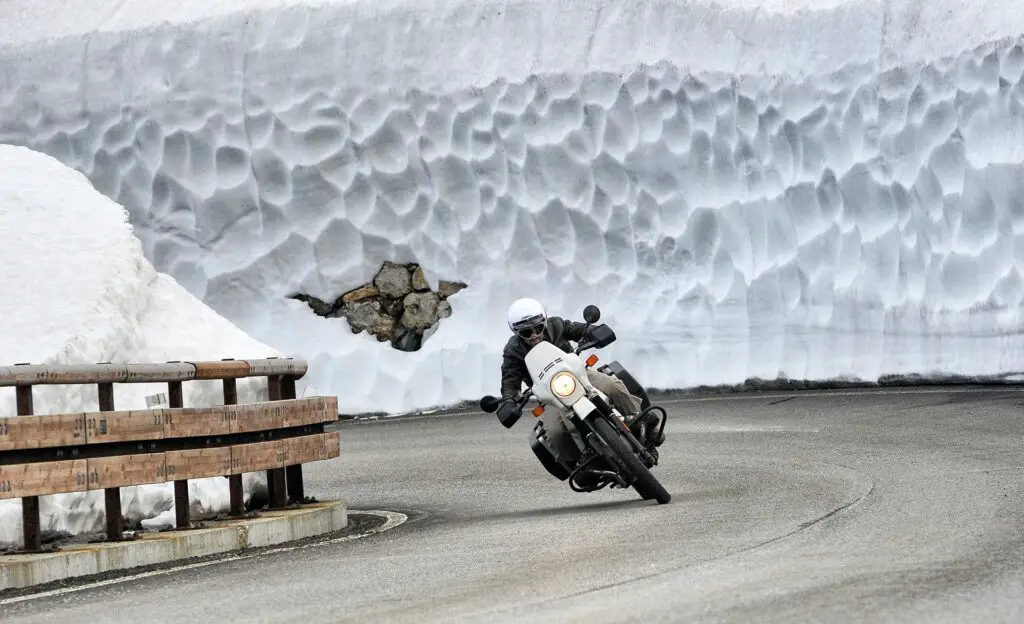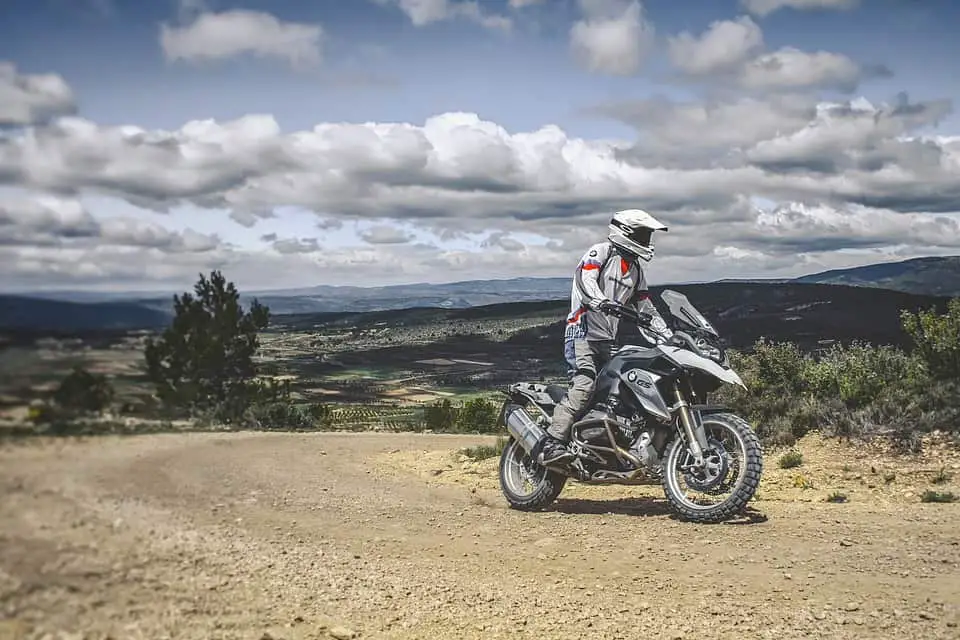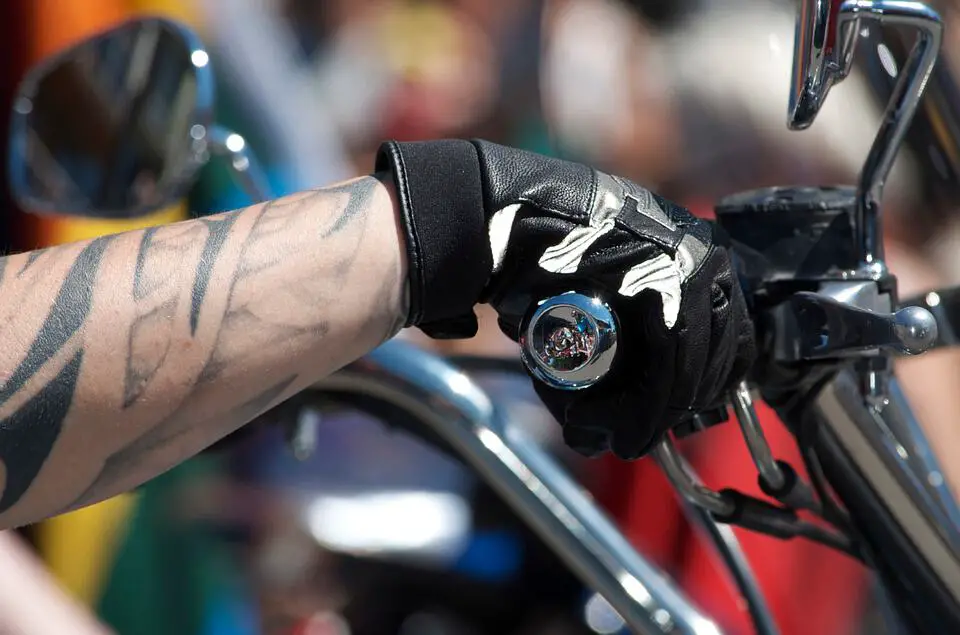Motorcycle grips aren’t usually the first thing you think of changing on your new motorcycle, but there are some really good reasons to replace your motorcycle grips. It isn’t just a matter of looks, and there are quite a few things you should consider when deciding which grips to purchase and how to install them.
In order to choose the best motorcycle grip for your bike, you need to consider size, shape, grip pattern, cost, thickness, material, comfort, style, durability, temperature, and ease of installation.
Keep reading for ten detailed tips on how to find the right grips, plus a bonus tip and the answers to some common questions about grip installation and removal. If you’ve ever considered replacing your motorcycle grips or need help choosing the right grips, this article is for you.
Tip: Looking for the best motorcycle grips available? This is a list with the best grips available right now. Check out all the motorcycle grips available at Revzilla (click)

How to choose motorcycle grips?
How exactly do you go about figuring out the right kind of motorcycle grips to buy? How many kinds are there? What are the differences? These eleven tips can help guide you in the right direction. These are eleven factors you need to consider when making a decision about motorcycle grips. My tip is to think carefully about each, and find out what you need before you make a purchase.
#1 – Size
Many motorcycle grips on the market come in a universal size. In theory, this means that they are guaranteed to work on any handlebars. Of course, I still recommend measuring your handlebar and the grips you’re thinking of purchasing.
It can be incredibly frustrating to get home with your purchase, only to discover the grips are too long or too short. While you can trim the grip, and some riders have confessed to shaving off the edges of the handlebar (not recommended), you can definitely save time and money by double-checking the length of the grips and the bar.
It can also be a good idea to research the make and model of your motorcycle to see what others have used. Some motorcycle grips are designed for specific bikes, and you might find that the specialized grips are the perfect match for you.
#2 – Shape
You might think that shape is a weird factor to consider when purchasing grips. After all, a grip is just a long tube that goes over the handlebar, right? Though a motorcycle grip is by nature a tube, there’s still a lot of variation that can happen in the shape.
Some grips are standard tubes that are straight and plain. They may have a pattern or be smooth and simple. Others are designed with contouring, meaning there is texture and there are raised points. Grips might have a special design for your palm to rest on or grooves for your fingers.
If you’re thinking of getting grips with contouring, I highly recommend you test them out before committing to make sure that your hand fits comfortably into the design. The shape of motorcycle grips is about comfort, so you want to make sure your hands are comfortable while you ride.
#3 – Grip Pattern
Along with shape, grips have different patterns. Some are smoother while others hold more texture. In some ways, the grip pattern is a matter of taste. It changes the look of your grips and is often an aesthetic choice.
However, the grip pattern also determines how good of a hold you can get. If the pattern is too smooth, your hands could slip, causing huge problems while driving. If the pattern has too much texture, you could feel like your mobility is impaired.
When deciding which grip pattern is most comfortable and safest for you, also think about whether or not you normally wear riding gloves. If you can, try out the grips while wearing your normal riding gloves to get a feel for how much your hands slide, or don’t.
#4 – Cost
Before you get too deep into your search for motorcycle grips, stop and make a budget. You can find decent grips for under $20, but most sit around the $50 to $100 range. Know how much you want to spend before you start looking.
Remember that cheaper doesn’t always mean better. Most cheap motorcycle grips won’t last as long, so you’ll have to replace them far more often than if you splurge for a quality product.
By that same token, more expensive doesn’t always mean better. Often you’ll find yourself paying more for color and style rather than functionality, so make sure you consider your priorities and stick to your budget.
#5 – Thickness
There are several different options in terms of grip thickness. The most important element here is hand size. If you have large hands, you’ll want a thick grip that you can comfortably rest your hands on. If you have small hands, you want a thin grip that won’t strain your hands while you ride.
If you need additional thickness, you can purchase grip puppies. Grip puppies are foam tubes you can place over a standard grip. These can add more comfort, but they can importantly give extra thickness to a grip in case you need a thicker setup than you can find elsewhere.
#6 – Material
Most motorcycle grips are made of rubber, possibly with metal elements. Other materials used in grips are leather, plastic, and foam. Leather and rubber are the most durable, and both can withstand strong temperatures.
The material you choose for your grip will affect the thickness, as mentioned above. You can get grips that have extra cushioning to protect from strong vibrations, or you can get lightweight grips that will work with small hands and on shorter rides.
#7 – Comfort
Comfort is perhaps the most important element to consider when choosing a motorcycle grip. After all, their main purpose is to enhance your comfort, and with it your safety, while you ride.
Without good motorcycle grips, you can have wrist problems, blisters, and sore muscles from the vibrations of the bike and the exertion of holding the handlebars, especially if you often take long rides.
Motorcycle grips make riding more comfortable, so that you can enjoy the ride and stay focused on the road instead of constantly shifting your hands to a more bearable position. When you’re choosing motorcycle grips, you should test them before committing.
Some grips may look great but be uncomfortable for you. For example, many ergonomic features can increase comfort when done right, but can cause issues if your hand isn’t the right fit or if you ride with unique hand placements.
#8 – Style
One of the reasons to buy new motorcycle grips is for style. There’s nothing wrong with adjusting features like this to give your bike the look you want. If style is important to you, there are grip options with rubber, leather, and metal that have unique looks.
You can find colored motorcycle grips and grips with interesting shapes and materials. After all, having chunky black motorcycle grips will make your bike look different than if you have thin grips with yellow stripes. In this department, it’s totally up to you.
#9 – Durability
One feature to consider when purchasing motorcycle grips is durability. This goes along with our point on cost. Motorcycle grips with a low price are cheaper in the short, but may add up in the long-run if you need to replace them twice as often.
Material is another thing to consider here, since thin, cheaper materials just won’t last as long as sturdier construction. The conditions you ride in will also affect durability. For example, if you often ride in the rain, leather grips might not be the right choice, since they’ll need to be properly dried every time they get wet.
#10 – Temperature
We’ll talk more about heated grips in a later section, but it’s worth touching on here. If you ride through the winter and in all weather, you might consider some heated grips. If you only ride on sunny days, give them a pass.
Also, consider the weather you usually ride in. Do your motorcycle grips need to be fairly water-resistant? Do you need to make sure they won’t crack in the heat? Temperature and weather are definitely factors to consider. Many brands will give you some information on how water or heat resistant the grips are so you can find ones that will last in your conditions.
#11 – Ease of Installation
Finally, my bonus tip is to consider the installation. Most motorcycle grips are easy to install and remove on your own. However, there are some that might be a little more complex or designed for specific bikes.
I suggest you look into how easy, or how difficult, the installation will be before deciding on a set of grips. You may find that it’s worth paying a few bucks extra in order to save a few minutes of installation time. Just don’t assume that all grips will be easy to install.

Tip: Looking for the best motorcycle grips available? This is a list with the best grips available right now. Check out all the motorcycle grips available at Revzilla (click)
Are heated motorcycle grips and other unique features worth it?
Heated grips
We briefly touched on heated grips. In case you haven’t heard of heated motorcycle grips, they’re grips with wiring that connects to the battery in order to warm the grips. If you often ride in cold weather, heated grips can be an excellent choice.
With heated grips, you’ll be able to keep your hands warm without having to wear the warmest gloves you can find that might sacrifice your control of the bike.If you ride year-round, keep in mind that heated grips usually have adjustable temperature, meaning you don’t have to keep them hot all the time or switch them out during the summer.
Anti-vibration
Most motorcycle grips come with anti-vibration features, and this is a feature that’s well worth it. In general, motorcycle grips are designed to block vibration to give you a more comfortable ride. Grips designed to stop vibrations are especially good if you often take long rides.
Puppy grips
Finally, an add-on feature for many motorcyclists are puppy grips. Puppy grips are thick foam pieces that can be placed over any motorcycle grip for extra comfort. They may feel too thick if you have small hands, but are also squishy so can mold to your hands.
As with most features of motorcycle grips, in the end the choice is up to you. The additional features you decide are necessary will depend on the length, temperature, and frequency of your rides.
Why buy new motorcycle grips?
At this point you may still be wondering why it’s necessary to buy new motorcycle grips. There are two main reasons: you want to upgrade the stock parts or you need to replace old grips.
The eleven tips for buying motorcycle grips listed above also explain why you might want to replace stock grips. A short answer would be that you might change out your grips for increased comfort, anti-vibration features, added temperature control, better grip, or fashion.
The wrong grips can hurt your hands, whether from forcing you into bad hand positioning or from constant strong vibrations. This can also lead to wrist pain that can last long after you’ve gotten off the bike.
Beyond comfort, bad grips can be dangerous. Without good grips, you have less control over the bike. Whether your hands are slipping around, your grips are slipping, or you just can’t get a good grasp, the loss of control can lead to an accident.
If you are uncomfortable with your grips or feel like you don’t have good control of the bike, you should definitely look into a grip upgrade. Changing grip pattern or style might give you better control without fear of your hands slipping off at an inopportune moment.
No matter what kind of grips you have, you will also need to replace them once they age. Aged motorcycle grips may show tearing or cracking. If you notice either, or if your grips are damaged in a crash or from a scratch, it’s time to replace them.
While grips may seem like an insignificant feature of a motorcycle, they can be dangerous if not replaced at the right time. Old grips will begin to lose the adhesive features that held them in place, and it can be incredibly dangerous to lose a grip while on the road or to have a grip slide around the handlebar while you’re riding.
Plus, a scratch or tear could lead to blisters, insufficient control, or hand/wrist problems. Replacing motorcycle grips is such an easy, cost-efficient thing that it’s well worth replacing them if in doubt.
What kinds of motorcycle grips are there?
We’ve already talked about how many variations there are in size, shape, and style for motorcycle grips. In general, they fall into three categories, though. These are ISO grips, billet rubber grips, and heated grips.
Heated grips we’ve also talked about. Wiring connects them to the battery so that you can warm your hands while you ride during the winter and on cold days.
ISO grips, which could be called isolating, are designed to isolate vibrations. They are ideal for long trips since they focus on vibration control and are therefore much more comfortable over time than standard grips.
Billet rubber grips, in contrast, are mostly designed for style. They are made of rubber with metal elements and can come with a lot of variation in appearance. If the look of your grips is important to you, these are probably the grips you should start with.

How do you put on and remove motorcycle grips?
You’ve finally done the research, calculated out the features that are important to you, and purchased some motorcycle grips. Now what? Thankfully it’s super easy to remove old grips and install new ones.
To remove the old motorcycle grips, you’ll first need to remove the end cap with an allen key. If you are trying to keep the old grip, you can slide a thin screwdriving underneath the grip. Spray with glass cleaner or soap to make it slippery. With the right amount of liquid and some fidgeting with the screwdriver, you should be able to slide it off.
If you aren’t concerned about saving the old grip, you can save a few seconds by using a knife to gently slice through the grip and peel it off that way.
Before removing your grips, take a moment to find out if you need to replace the throttle sleeve. You’ll have a little more work cut out for you if you need to remove the throttle sleeve and install a new one. You’ll know you need to change out the throttle sleeve if your grips are integral-tube style grips.
Now that the old grips are removed, clean and dry the bars and prep for the installation. If the grips you purchased are lock-on grips, this next step is easy. Just slide on the grips and secure the built-in clasp. The grips will most likely come with easy-to-follow instructions specific to the grips you bought.
If you didn’t purchase lock-on grips, you’ll need to decide how you want to secure your grips. While grip glue exists and is a common choice, it isn’t the only choice. Many motorcyclists swear by products from hairspray to spray paint to secure motorcycle grips. We’ll get into some of the different opinions.
Grip glue is a strong adhesive that usually comes in a small tube for easy application. It can be quite messy, but it ensures that your grips stay in place while you ride. It’s durable and was designed specifically for this purpose, so I definitely recommend it.
That being said, motorcycle forums are filled with alternatives. For a product to work as a grip glue, it needs to dry quickly, withstand water and weather, and bond rubber and aluminum. I’ve heard people use hairspray, spray paint, soap and water, goop (which needs at least 24 hours to cure before riding), and superglue.
Another option is to secure the grips with wire. This can be done on its own or in conjunction with one of the alternatives mentioned above. In fact, if you do use one of these alternatives to grip glue, I highly recommend you also use wire to make sure the grips are secured in place.
Now, installing grips is different depending on what you purchased. In essence, you apply the adhesive of choice, slide on the new grip, and secure with the end cap. Let the motorcycle grips sit for a few hours to make sure the adhesive has fully dried. Secure with wire if desired.
Tip: Looking for the best motorcycle grips available? This is a list with the best grips available right now. Check out all the motorcycle grips available at Revzilla (click)
Motorcycle grip maintenance
Before we conclude, I wanted to give a shout out to motorcycle grip maintenance. Like all parts of a motorcycle, the grips will last longer if you care for them. Proper maintenance will expand their life and help you stay on top of necessary repairs or replacements before the problem becomes dangerous.
To care for your grips, all you really need to do is focus on cleaning. Wipe down the grips after a ride and occasionally give them a thorough cleaning, trying to get into any cracks and crevices of the grip pattern.
Another way to increase the lifespan of your motorcycle grips is to dry them properly. Even though motorcycles should be able to get wet, they also should be dried well to prevent rust or other problems. In the same way, you should take the time to dry your motorcycle grips fully to prevent rust, mold, or cracked materials.
Finally, part of maintenance is making sure that every part of your motorcycle is in top condition. If you are regularly cleaning your grips, you’ll notice right away when they start to show signs of wear and tear or when they begin to move around on the bar. If you see these signs, replace the grips as soon as possible to prevent an accident from lack of control.
Are all motorcycle grips the same size?
I covered this in the ten tips above, but this is such a common question and such an important point that I thought it was worth reiterating. Motorcycle grips are not all the same size.
Motorcycle grips are usually measured by their diameter and typically come in 1” or ⅞”. Be sure to measure your handlebars or old grips to compare before purchasing grips. Although many grips claim to be a universal size, you should also double check to make sure they do indeed fit.
If you aren’t sure about your measurements, you can research the make and model of your motorcycle to get an idea of what size grips will work for you.
Final thoughts: purchasing motorcycle grips
Here’s my conclusion: before you buy motorcycle grips, you need to take the time to decide what exactly you need. Here are some questions you should ask yourself before you start looking for what to buy.
- How long is my average ride?
- What temperature do I usually ride in?
- How long do I want my grips to last?
- How important are looks when it comes to my bike?
- Do I want color in my motorcycle grips?
- Does the vibration bother me while I ride?
- Do I often ride in rain or snow?
- Do I want motorcycle grips that are ergonomic?
- What size motorcycle grips do I need?
Once you’ve gotten answers to these, you’ll have a better idea of what you’re looking for. As you begin to search, you can start crossing off grips that don’t meet your criteria and prioritizing which needs are most important.
If you find ones you love, make sure to make note so you can purchase them again once this set wears out, gets scratched, or gets loose. Replacing the motorcycle grips will always be cheaper than paying for a crash because your grip slipped.
